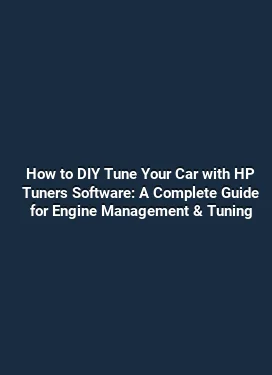Best Budget ECU Tuning Options Under $500 for Beginners
For car enthusiasts and new tuners alike, making informed choices about engine management within a modest budget is both a science and an art. The world of electronic control units (ECUs) and after-market tuning devices offers a range of options that can fit under a $500 price point, especially for beginners who want to experiment, learn, and gradually refine their setup. This guide dives into practical, beginner-friendly paths, highlighting plug-and-play solutions, handheld programmers, and basic piggyback systems that can deliver tangible improvements without overwhelming complexity or cost.
Understanding Budget-Friendly Tuning Pathways

When approaching ECU tuning on a budget, the goal is to achieve meaningful gains without introducing unnecessary risk. The most accessible routes typically fall into three broad categories: plug-and-play reflashes and handheld programmers, piggyback controllers, and data-logging and diagnostic tools. Each path has its own set of trade-offs in terms of ease of use, degree of control, and compatibility with different engines and vehicles.
Begin with a clear picture of what you want to achieve. Do you seek smoother idle, improved throttle response, better mid-range torque, or higher efficiency under light loads? Defining your objectives helps guide equipment choices, integration steps, and testing plans. It also reduces the risk of chasing unrealistic gains or creating drivability issues. A structured approach that combines hardware with prudent experimentation yields the best long-term results for a beginner working under $500.
Plug-and-Play Reflashes and Handheld Programmers
Plug-and-play reflashes and handheld programmers are the most popular entry point for budget-conscious beginners. They come in several flavors, from manufacturer-backed “race” mappings to third-party tunes designed for a range of common engines. The key advantage here is simplicity: connect the device, select a predefined map, and flash or load the tune with minimal mechanical intervention. The upside is speed and a lower learning curve, while the downside can be limited customization and potential gaps in warranty coverage if the device is not approved by the vehicle manufacturer.
Practical tips for using these devices: choose a device with vehicle-specific support and a reputable community or vendor track record. Before flashing, capture a thorough baseline of your engine’s stock behavior, including idle quality, throttle response, and any fault codes. After applying a tune, perform controlled tests on local roads or a private testing environment. Compare the new behavior with the baseline data, focusing on drivability and any shifts in power delivery. If at any point the engine exhibits detonation, misfires, or unusual shaking, revert to the stock map and re-check wiring and sensor connections.
Choosing the Right Device for Under $500

Look for devices that explicitly mention compatibility with your vehicle year and model, and avoid devices that claim universal applicability without verifying outcomes. Prioritize devices with clear documentation on supported parameters, such as fuel tables, ignition timing, and idle control. Community reviews and independent testing can provide valuable insights into real-world performance changes. If your goal includes better fuel economy, check whether the device offers adaptive learning features and data-logging to monitor long-term behavior without manual adjustments.
Piggyback Controllers: A Flexible Yet Budget-Friendly Approach
Piggyback controllers sit between stock ECUs and the engine, offering an additional layer of parameter adjustment without full reprogramming. They can modulate sensor signals and injector timing, often providing a safety buffer to protect against overly aggressive maps. For beginners, piggybacks present a controlled way to explore performance improvements while maintaining compatibility with stock engine protection strategies. The critical factor is to select a piggyback that supports your engine family and provides a straightforward interface for calibration and testing.
Key considerations when using piggybacks include: ensuring compatibility with your vehicle’s sensors and PCM (Powertrain Control Module), understanding the safety interlocks (such as knock detection and long-term fuel trims), and planning a staged calibration approach. Start with conservative adjustments to air-fuel ratios at mid-range RPMs and gradually expand to other operating regions. Document all changes and perform repeatable tests to confirm that improvements are consistent rather than episodic. Always monitor engine temperature, knock events, and readiness codes to avoid drivability issues.
Practical Calibration Strategies with Piggybacks
Begin with a baseline log from a safe driving session. Identify a stable RPM range where the engine spends most of its time, and adjust the piggyback's map to smooth the engine response in that zone. A common beginner technique is to slightly lean or enrich the mixture at specific throttle openings to balance power and efficiency, then verify that the change doesn’t trigger knock or overheating. Use a simple data-logging workflow: record sensor data, compare to baseline, and make incremental tweaks in small steps to preserve drivability.
Another essential practice is to maintain a conservative approach to timing adjustments. Advancing timing can yield power but raises the risk of knock, especially in engines with variable ignition timing or forced induction. For naturally aspirated engines, modest timing enhancements in the mid-to-high RPM range can yield a noticeable improvement in response, but always verify with a controlled pull on a safe road or dyno session where available.
Data-Logging and Diagnostic Tools for Learning
Having a reliable data-logging setup is invaluable for beginners. Data logs reveal the true behavior of the engine under different conditions and help validate the impact of tuning changes. Basic tools include a wired or wireless OBD-II adapter, a companion app or software, and a dashboard that displays essential parameters such as air-fuel ratio, throttle position, MAF (mass air flow), RPM, and engine temperature. Even on a modest budget, a straightforward data-logging workflow empowers beginners to make informed decisions and avoid speculative tuning.
Practical data-logging strategies: start with short runs at different loads (idle, light acceleration, and steady cruise) to establish baseline ranges for critical sensors. After applying a tuning change, repeat the same runs and compare the captured data. Look for unintended shifts in sensor readings, prolonged injector duty cycles, or rising exhaust temperatures. The goal is to build a repeatable method for diagnosing issues and confirming that performance gains are real and safe.
Interpreting Logs: What to Watch For
Key indicators of a healthy tune include stable trim values, consistent MAF readings aligned with throttle input, and a smooth power curve without abrupt surges. Watch for excessive long-term fuel trim corrections, which may indicate a tune that is too aggressive for the engine’s current condition or fuel quality. Detonation or pre-ignition warnings are critical red flags; if detected, revert to a safer map and re-check cooling, fuel quality, and sensor health before attempting further adjustments.
Safety, Warranty, and Real-World Considerations
Budget tuning options must be evaluated with safety and reliability in mind. While affordable devices can deliver noticeable improvements, improper use can compromise engine longevity, emission compliance, and warranty coverage. It’s important to understand the policy of your vehicle’s manufacturer and any applicable local regulations regarding aftermarket engine management modifications. In many cases, keeping a stock baseline and performing limited, well-documented experiments are the prudent path for beginners, especially on daily drivers or vehicles under warranty.
Practical safety practices include performing tuning experiments in controlled conditions, ensuring the cooling system is in optimal condition, and avoiding high-load attempts on a hot engine. Regular maintenance—oil, filters, spark plugs, and sensors—supports consistent performance and reduces the likelihood of misbehavior after tuning changes. When in doubt, consult with a reputable tuner or join a community of like-minded enthusiasts to share logs, maps, and testing experiences in a collaborative environment.
Roadmapping Your Learning Journey
Approaching ECU tuning as a journey rather than a one-off task helps beginners develop a sustainable workflow. Start with basic knowledge about engine management principles, learn the layout of your vehicle’s sensors and actuators, and gradually build a library of tested, verified maps or adjustments. A well-documented learning path might include: baseline measurements, a first safe tune within the budget constraint, a structured testing plan with day-to-day logs, and a final assessment comparing stock versus tuned behavior across driving scenarios. This approach fosters confidence, reduces risk, and accelerates the acquisition of practical skills that extend beyond a single device or vehicle.
As you gain experience, you can explore more advanced topics such as learning to interpret knock sensor feedback in real time, understanding throttle-by-wire behavior, and correlating transmission behavior with engine management decisions. The result is a more intuitive sense of how small, incremental changes accumulate into meaningful, safe performance improvements, all while staying within a practical budget and a beginner-friendly learning curve.
Common Mistakes to Avoid
Many beginners make the mistake of chasing peak horsepower without validating drivability and reliability. It’s essential to measure real-world comfort, throttle response, and transmission shifts, not just peak torque numbers. Another frequent misstep is underestimating the importance of safe engine temperature management. Overly aggressive maps can raise exhaust gas temperatures and stress components, particularly in hot climates or heavy-city driving. Finally, neglecting documentation and systematic testing can turn a simple upgrade into a minefield of inconsistent behavior. A disciplined approach—documenting each change, recording baselines, and testing in repeatable conditions—positions a beginner for steady progress and fewer surprises.
Respecting fuel quality and octane ratings is also crucial. Some budget tunes assume premium-grade fuel, while others optimize for regular gasoline. Aligning the tune with the fuel you actually use helps preserve engine health and ensures expected performance without detonation risk. In all cases, incremental progress and cautious evaluation trump aggressive experimentation at every turn.
Getting Started: A Step-by-Step Quick Start Plan
1) Define goals: clarity on desired drivability and efficiency helps select the best budget option. 2) Inspect the vehicle: confirm age, condition, and sensor health. 3) Choose a device or piggyback with solid community feedback and vehicle-specific support. 4) Record baseline data: capture idle, light throttle, and moderate acceleration. 5) Implement a conservative tune: start with modest adjustments in the mid-range, avoiding extreme maps. 6) Test and log: perform controlled tests, compare to baseline, and refine gradually. 7) Reassess and iterate: once you’re comfortable, explore small, safe refinements or supplementary data-logging improvements. 8) Maintain the system: periodic checks of sensors, wiring, and cooling ensure long-term reliability.
By following a structured sequence, beginners can achieve meaningful results while keeping the process approachable and sustainable within a $500 budget.






